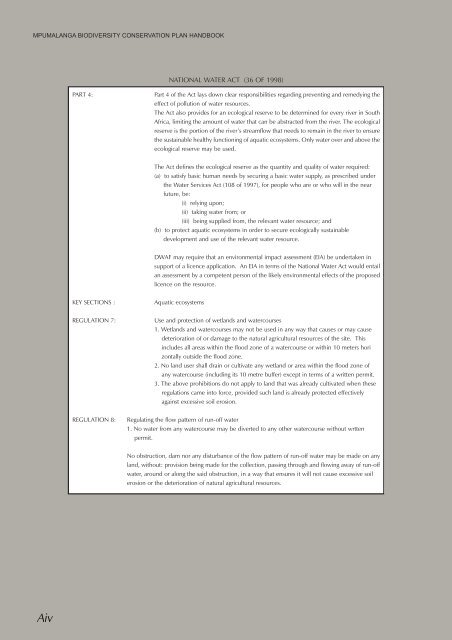Mpumalanga Biodiversity Conservation Plan Handbook - bgis-sanbi
Mpumalanga Biodiversity Conservation Plan Handbook - bgis-sanbi
Mpumalanga Biodiversity Conservation Plan Handbook - bgis-sanbi
You also want an ePaper? Increase the reach of your titles
YUMPU automatically turns print PDFs into web optimized ePapers that Google loves.
MPUMALANGA BIODIVERSITY CONSERVATION PLAN HANDBOOK<br />
Aiv<br />
PART 4: Part 4 of the Act lays down clear responsibilities regarding preventing and remedying the<br />
KEY SECTIONS : Aquatic ecosystems<br />
NATIONAL WATER ACT (36 OF 1998)<br />
effect of pollution of water resources.<br />
The Act also provides for an ecological reserve to be determined for every river in South<br />
Africa, limiting the amount of water that can be abstracted from the river. The ecological<br />
reserve is the portion of the river’s streamflow that needs to remain in the river to ensure<br />
the sustainable healthy functioning of aquatic ecosystems. Only water over and above the<br />
ecological reserve may be used.<br />
The Act defines the ecological reserve as the quantity and quality of water required:<br />
(a) to satisfy basic human needs by securing a basic water supply, as prescribed under<br />
the Water Services Act (108 of 1997), for people who are or who will in the near<br />
future, be:<br />
(i) relying upon;<br />
(ii) taking water from; or<br />
(iii) being supplied from, the relevant water resource; and<br />
(b) to protect aquatic ecosystems in order to secure ecologically sustainable<br />
development and use of the relevant water resource.<br />
DWAF may require that an environmental impact assessment (EIA) be undertaken in<br />
support of a licence application. An EIA in terms of the National Water Act would entail<br />
an assessment by a competent person of the likely environmental effects of the proposed<br />
licence on the resource.<br />
REGULATION 7: Use and protection of wetlands and watercourses<br />
1. Wetlands and watercourses may not be used in any way that causes or may cause<br />
deterioration of or damage to the natural agricultural resources of the site. This<br />
includes all areas within the flood zone of a watercourse or within 10 meters hori<br />
zontally outside the flood zone.<br />
2. No land user shall drain or cultivate any wetland or area within the flood zone of<br />
any watercourse (including its 10 metre buffer) except in terms of a written permit.<br />
3. The above prohibitions do not apply to land that was already cultivated when these<br />
regulations came into force, provided such land is already protected effectively<br />
against excessive soil erosion.<br />
REGULATION 8: Regulating the flow pattern of run-off water<br />
1. No water from any watercourse may be diverted to any other watercourse without wrtten<br />
permit.<br />
No obstruction, dam nor any disturbance of the flow pattern of run-off water may be made on any<br />
land, without: provision being made for the collection, passing through and flowing away of run-off<br />
water, around or along the said obstruction, in a way that ensures it will not cause excessive soil<br />
erosion or the deterioration of natural agricultural resources.<br />
M P U M A L A N G A<br />
<strong>Biodiversity</strong><br />
CONSERVATION PLAN HANDBOOK

















